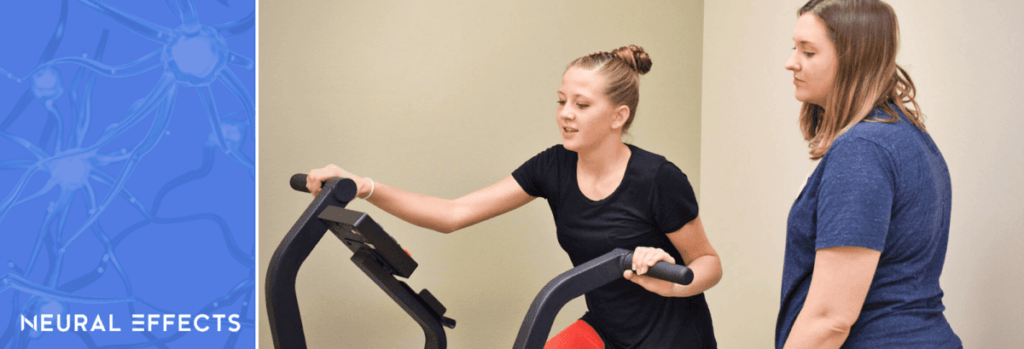If you’ve recently sustained a concussion, you can increase your chances of making a full recovery by following a good concussion recovery protocol. Our step-by-step guide takes away guesswork about how much time to rest or when it’s time to go back to work. It also gives you specific guidelines for each stage of recovery and explains what to expect.
Many people with a concussion are told by their doctors to sit in a dark room and rest. Then, when symptoms don’t go away, they are told to rest some more. But is this really the best approach?
At Neural Effects, we think there’s a better way to increase the chances of a quick and full recovery. Studies show that challenging the brain with physical exercise and cognitive tasks soon after the injury results in faster recovery rates than just sitting in a dark room waiting for symptoms to subside.
However, it’s important to know how much and when to challenge the brain. Pushing too hard or not hard enough could both result in a longer recovery process. To help you find the right balance, this four-step plan involves a balance of physical exercise, cognitive games, and a gradual return to normal activities based on how your symptoms respond.
In this article, we’ll go through the four-step recovery plan in detail, as well as other questions you may have about your recovery:
- The four-step concussion recovery protocol.
- What to expect from treatment at Neural Effects.
- How long it takes to recover from a concussion.
- How to know when you’re fully recovered.
- When you can return to organized sports.
- Answers to frequently asked questions.
If you live in Provo, Salt Lake City, or anywhere else in the Utah valley area, we can help you recover from your concussion and reduce your chance of long-term symptoms. We are in network for most types of medical insurance. Schedule your evaluation today.
The 4-Step Concussion Recovery Protocol

There are four steps to concussion recovery:
Step 1: Get evaluated as soon as possible after your injury.
Step 2: Rest for one to two days after the injury.
Step 3: Start therapy and gentle activities.
Step 4: Gradually return to work or school and normal exercise.
These may sound simple enough, but in practice, they can be difficult to follow unless you have something helping you monitor your progress. Here are more details on how to follow each step of the protocol.
Step 1: Get Evaluated as Soon as Possible after the Injury
After your traumatic brain injury, the first step is to get a thorough assessment as soon as possible to determine the extent of your mild traumatic brain injury.
The best place to get this evaluation is a concussion clinic such as Neural Effects. Our team of neurology specialists can offer you a more complete assessment than doctors who are less specialized in this type of brain injury.
During the evaluation, we ask each patient to rate their symptoms from zero (no symptoms) to six (worst possible), allowing us to understand what systems are most affected. In conjunction with their medical history, this information will guide the therapy we offer.
For more severe cases, we may need a CT-scan or an MRI, to rule out bleeding in the brain or skull/neck fractures. If you’ve done these scans before, we can review them along with your medical history.
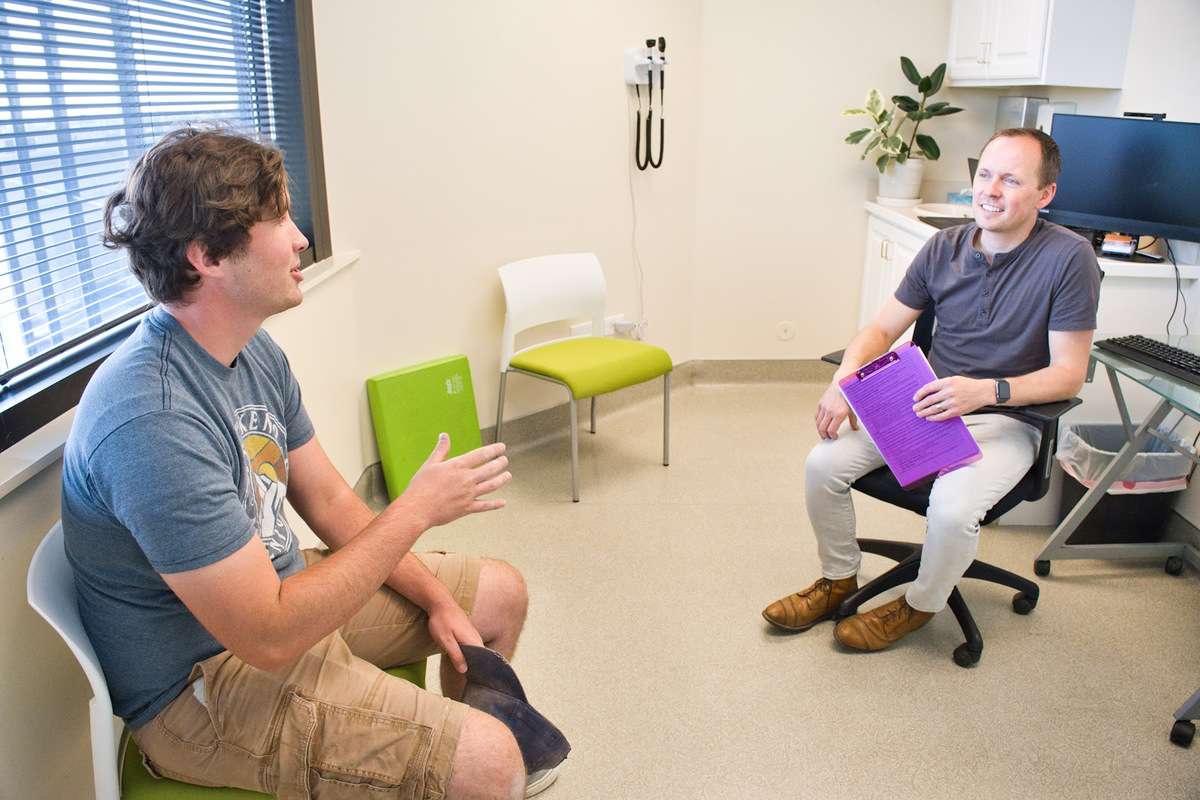
Next, patients undergo a series of physical exams to assess how they’ve been affected by the head injury. In the cranial nerve exam, we assess multiple nerves that control movements in the face and examine their sensory function. Our team also conducts a cervical spine exam to look for any signs of a fracture or a herniated disc in the spine, neck, arms, and hands.
The final assessment is called a Balance Error Scoring System (BESS), in which patients complete a series of simple balance exercises with their eyes closed.
Based on the results from these tests, our team designs a treatment plan to suit your needs.
Step 2: Rest for One to Two Days
Immediately after your concussion, you need to rest for 48 hours. During this period, the brain needs both physical and cognitive rest to deal with the injury.
Even if you don’t have severe symptoms, don’t ignore this rest period. Studies show that a lack of mental rest immediately after a concussion can lead to prolonged or worse symptoms and make the brain more susceptible to a repeat injury.
Examples of physical rest include:
- No sports or physical activity of any kind.
- No strenuous house chores.
- No work.
- No school.
Examples of cognitive rest include:
- No work or school.
- No schoolwork or homework.
- No use of electronic devices, including phones and computers.
- No reading or playing instruments.
- Limited socializing.
- No loud noises, bright lights, or any forms of intense sensory stimulation.
- No driving or other activities that require a quick reaction time.
What Can I Do during These 48 Hours?

From the lists above, you may think there’s not much you can actually do, and it’s best just to stay in bed. However, brain rest does not mean you have to sit in the dark for two days, and there are some activities you can do safely:
- Meditate.
- Take a bath.
- Have a relaxing massage or spa experience.
- Listen to soft/relaxing music at a low volume.
- Perform light home activities, such as helping set the table.
- Take a slow, short walk.
- Sit outside in the garden (as long as the sunlight doesn’t trigger any symptoms).
- Talk to friends on the phone.
Step 3: Start Therapy and Gentle Activity
Recent studies have shown that there is no added benefit to having a period of rest longer than 48 hours. Both exercising and doing cognitive tasks soon after the injury can improve the chances of a full recovery.
In fact, one study showed that cognitive games after a concussion increased heart rate variability, which is a sign that the parasympathetic nervous system was activated by the task.
Briefly, the autonomic nervous system (ANS) contains two sections: the sympathetic (SNS) and the parasympathetic (PNS) nervous systems, which work together and are active at different times during the day. Concussions change this rhythm, and many patients have an SNS that is “stuck” in the overactive state after their injury.
Going back to the results from the study, the researchers showed that cognitive tasks only a few days after the concussion were enough to trigger the parasympathetic nervous system into action, which means engaging in cognitive tasks is crucial for recovery (you can find out more about how the ANS is involved in brain injuries here).
So, after 48 hours, you can start a gradual return to normal activities, including work and school. If you play organized sports, you will need more than 48 hours before you can return to play (see below for more details about returning to sports).
Start with easy activities, and progressively add more as your symptoms fade. Just make sure you’re not adding an activity that may increase the risk of a second concussion. Going for a walk is fine; rock climbing is not.
Every time you add something new — whether it is a physical or mental activity — pay attention to how your body reacts, and watch out for warning signs. If your symptoms don’t get worse, you can gradually increase the intensity/duration and add other more strenuous activities.
If your symptoms do get worse or come back, ask yourself how much worse they are. Use the rule of threes: If your headache increases from a 2 to a 5 in your opinion, that’s a clear signal to stop. Or if you have three different symptoms increase — such as drowsiness, headache, and nausea — that’s also a good sign to stop.
If an activity is too much for you, go back to the previous activity level and try again in a few days. Symptoms may appear a few hours later or even the next day, not necessarily during the activity. Give your brain some time to adjust to the new activity, and don’t add more than two or three per day.
Treatment at Neural Effects
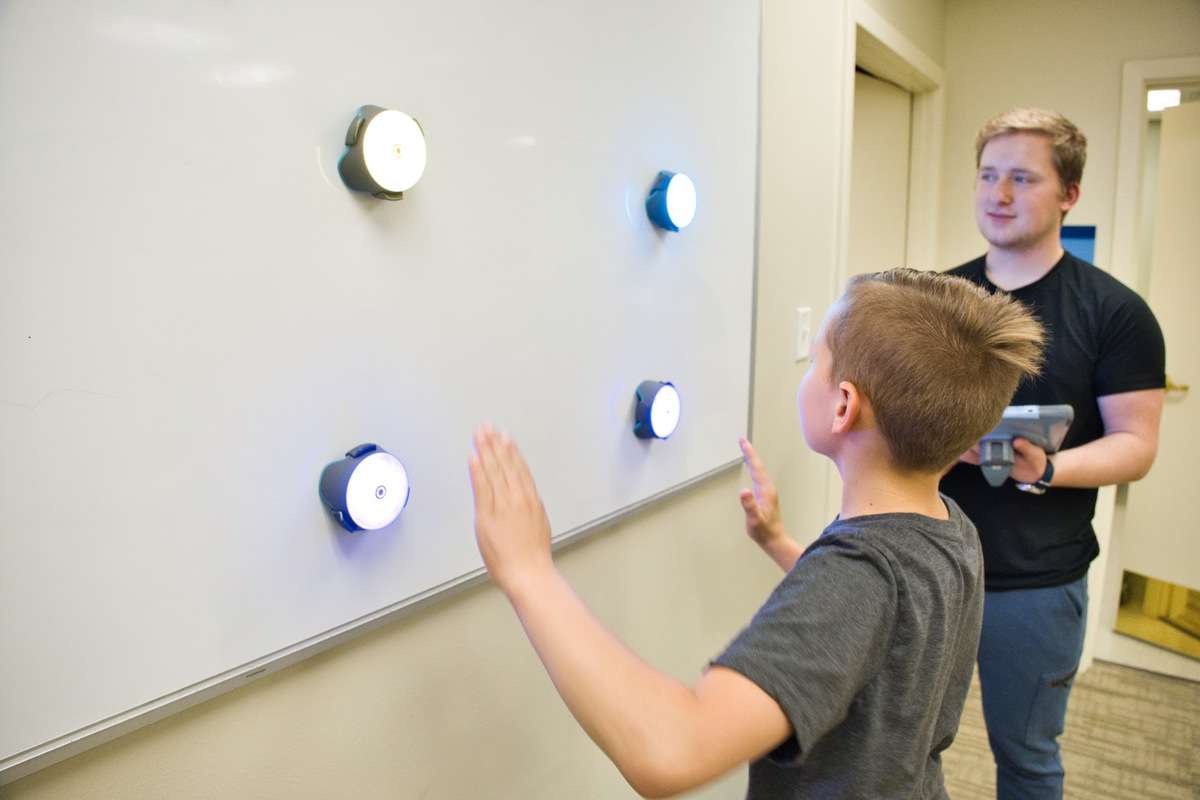
After the 48-hour period of rest, you can also start therapy. For most patients who come to our clinic, this means starting right after receiving a concussion diagnosis.
Typically, each patient receives three one-hour sessions a week for two weeks, but this can be adjusted if patients need more or fewer sessions. The general format for each session includes cardio exercises and breathing techniques, as well as vestibular, neuromuscular, and cognitive therapy.
We know how important exercise is during recovery. Physical activity releases a cascade of neurochemicals in the brain which are crucial in the healing process (you can read more here about how cardio exercise helps patients recover). Part of our sessions includes cardio exercise, typically on a treadmill or stationary bike. The aim is to raise your heart rate enough to improve blood flow in the brain — especially the areas affected by the injury — but not enough to trigger any of your symptoms. This is called exercising at the sub-symptom threshold.
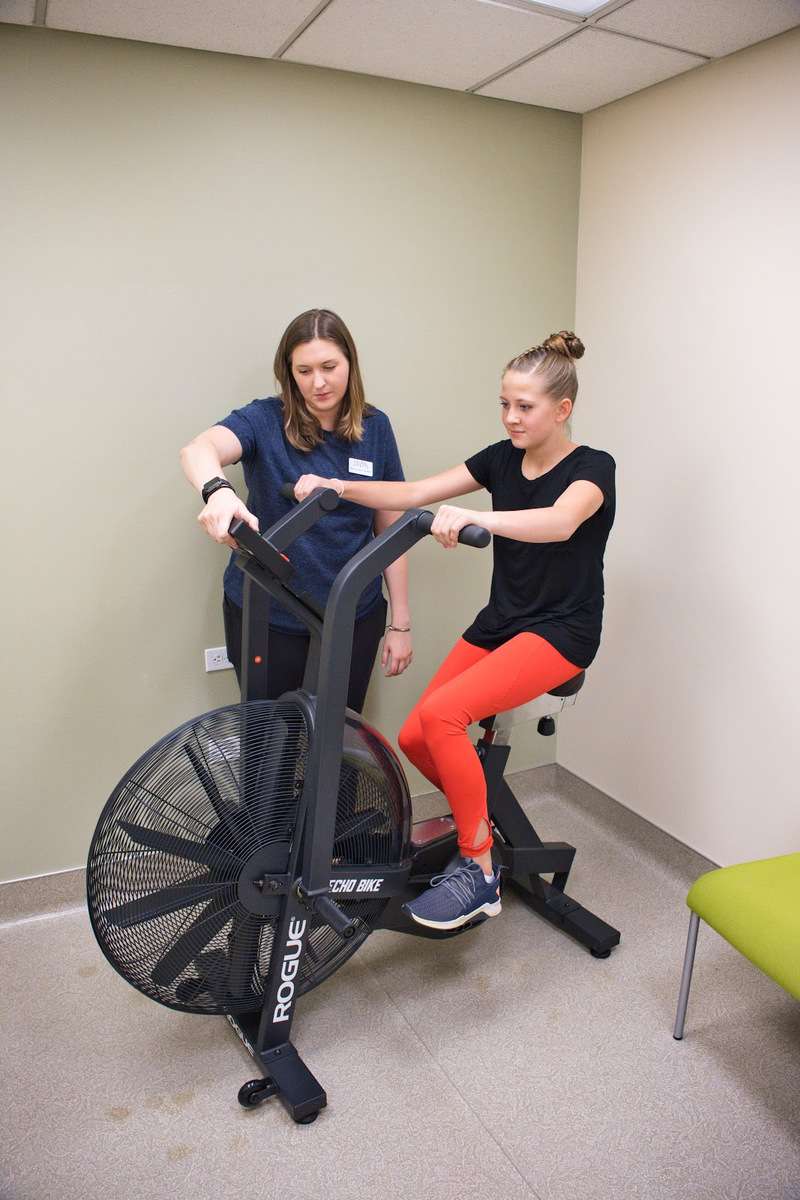
This is combined with breathing techniques to teach patients how to recover from exercise without triggering symptoms. This is an important step in your recovery, and we spend a considerable amount of time showing you a variety of techniques that you can use at home after treatment.
Some of the most common symptoms after a concussion are either related to vision (blurry vision and light sensitivity) or balance (dizziness and vertigo). We address these symptoms with ocular (vision) and vestibular (spatial orientation) therapies. The main purpose for these exercises is to get the eyes and vestibular system working in harmony again.
To help with their cognitive skills, patients have to complete neurocognitive tests. These are presented as games, such as finding hidden patterns, solving logic games, and memorizing images. The last type of therapy used in these sessions is neuromuscular therapy, which works both body and brain simultaneously. We use a variety of exercises, such as hitting targets with lights in random patterns to improve reaction time or balancing on a Bosu ball and playing a memory game at the same time.
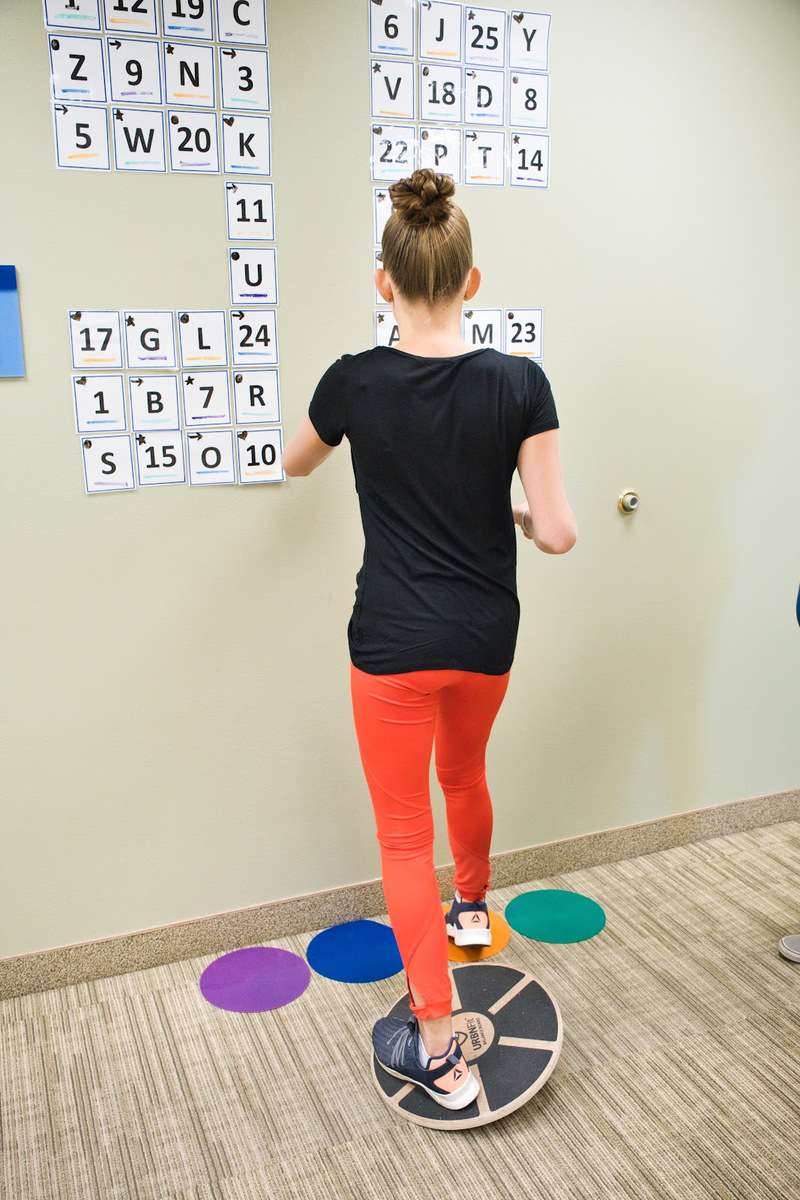
After each session, our therapists will give you a list of follow-up exercises to do at home. This typically includes cardio, cognitive games, and breathing techniques. Doing these exercises gives you a better chance of a complete recovery.
Step 4: Gradual Return to Work and School as Directed by Physician or Therapist
Return to Work
After you’ve recovered at home and can manage your symptoms, you may feel you’re ready to go back to work. It’s important that you make this decision together with your medical care team.
Brain injuries can affect patients in unexpected ways, and you must be prepared for the fact that you may not be able to do your job as before, at least temporarily.
This doesn’t mean you cannot return to work, but you may need to make some adjustments to accommodate your needs:
- Return to work gradually. Maybe start at only a few days a week or with shorter hours.
- Take plenty of breaks during the day.
- Take up an easier role or reduce your workload.
- Prioritize what you absolutely need to do in order to manage your energy levels effectively.
- Ask for help when you need it.
For most adults, driving the car to work, going shopping, or picking up the kids from school is an essential daily activity. However, it may be difficult to predict when it’s safe to drive again after a concussion.
A study showed that patients with concussions take longer to stop at traffic lights and are slower to respond in situations that require split-second decisions to avoid collisions. The researchers suggested that driving skills — which involve fast reaction times that could be the difference between life and death — may take the longest to regain after a concussion, even when other symptoms have resolved.
Follow the advice of your doctor, and if you try to drive and struggle with your symptoms or feel unsafe, it’s a sign that you may not be ready yet.
Return to School
Children should follow a similar gradual return to school, guided by their pediatric doctor. Work with their teachers to make sure someone monitors their symptoms and gives them extra breaks when needed. Children may need extra medical attention and some adjustments to ensure they can manage their symptoms, such as moving away from bright lights or avoiding noisy lunchrooms. Some schools have written policies for helping their students return to school after a concussion. Check with your child’s teachers to see if this is the case for you.
How Long Does It Take to Recover from a Concussion?
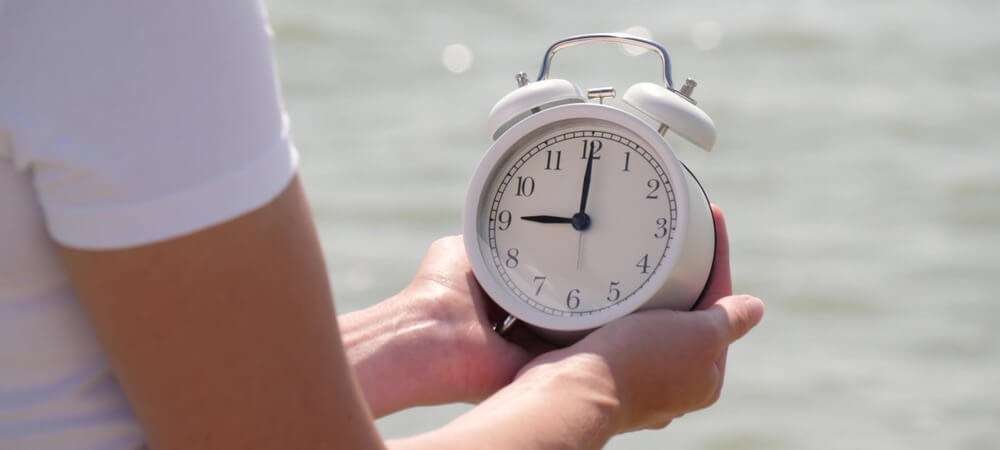
For high school students, concussion recovery takes about seven to 10 days. Some patients may experience symptoms for up to three months. If you’re still struggling with a brain injury that occurred months or even years ago, then you may have post-concussion syndrome (PCS). If you want to find out more, our sister clinic Cognitive FX specializes in treating this condition.
For concussions, one of the factors that influences speed of recovery is when treatment starts. Ideally, you should start as soon as possible after your 48 hour rest period to have the best chance of making a full recovery. In contrast, a late start is associated with a longer recovery period.
A history of previous concussions occurring in a short period may also slow down recovery for the latest head trauma, most likely due to an increased vulnerability after repeated injuries.
There are also some personal factors that can influence recovery, such as age and gender. Children, adolescents, teenagers, and older adults seem to take longer to recover compared to healthy adults. For example, studies show that concussed high school athletes take longer to recover from neurocognitive deficits than adult athletes.
In addition, women are not only more likely to suffer cognitive problems after a concussion, but they also take longer to recover and show more symptoms than men. Other risk factors that may prolong recovery time include mood disorders, learning disabilities, and psychiatric illness, as well as a history of migraines before the concussion.
Finally, support by family members plays a key role in the recovery of adults with a TBI. Family and friends should be seen as partners in the rehabilitation process, and their support is associated with a fast improvement in concussed patients. This includes not only practical help such as financial assistance or transportation, but also to build a sense of social inclusion with loved ones and avoid feelings of isolation.
What Are Some Extra Steps I Can Take to Speed Up My Recovery?
In addition to following the protocol described above, there are more steps you can take to heal from a concussion faster. Keep in mind they also address what to do about persistent symptoms, which you may not need to deal with:
- Get extra sleep and rest as needed. Concussions can interfere with your sleep quality (read more about sleep after a concussion here).
- Refrain from drinking alcoholic beverages, and limit caffeine until the doctor says it is safe (learn more about alcohol, caffeine, and concussion recovery).
- Eat a brain-boosting diet, and stay hydrated (read about how to plan for recovery by eating a balanced diet).
- Exercise as much as you can without triggering your symptoms (find out how cardio helps patients recover).
- Do your best to maintain a positive mindset, and be patient with yourself.
How Will I Know When I’m Healed?

You can see when scratches and cuts are healed, and you can get an X-ray to see if your broken leg is mended. Concussions can’t be “seen” in the traditional sense, so it can be challenging to assess when a person is completely healed from a brain injury.
Usually, your physician or therapist will consider you fully recovered when:
- You have no or minor symptoms, even after an intense exercise session.
- You’ve regained all your cognitive skills, such as memory and concentration.
- You feel back to normal.
When Can I Return to Organized Sports after a Concussion?
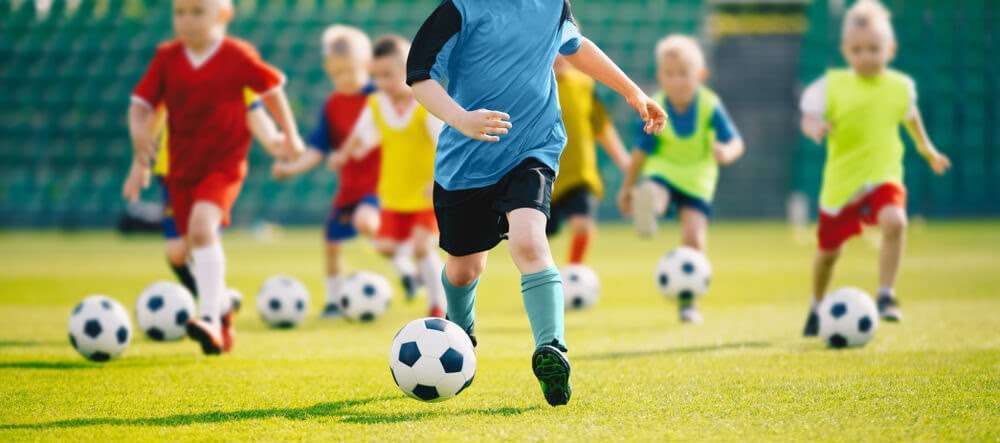
After a sport-related concussion, athletes should only return to training after approval from a healthcare provider. The Centers for Disease Control and Prevention (CDC) HEADS UP program recommends six steps to ensure a safe return for every athlete. The protocol is a gradual process, and it may take anywhere from days to months to complete.
Step 1: Back to Regular Activities (Such as School)
After the first two days, athletes can begin their gradual return to regular activity. This includes very light activity, such as short walks or riding a few minutes on a stationary bike, as long as it doesn’t trigger symptoms.
Step 2: Light Aerobic Activity
The second phase involves light aerobic exercise, such as five to 10 minutes on an exercise bike, and light jogging. The aim is to increase the athlete’s heart rate.
Step 3: Moderate Activity
Athletes can move on to moderate activities, including running, stationary biking, or weightlifting. This should still be less time and less intense than their regular routine.
Step 4: Heavy, Non-Contact Activity
At this stage, athletes should be able to start non-contact physical activity, such as sprinting, high-intensity stationary biking, and any other non-contact drills specific to each sport.
Step 5: Practice and Full Contact
Athletes can return to practice and full contact, if needed for the sport, under controlled conditions.
Step 6: Competition
Athletes are free to return to normal training and competition.
Progressing through the Protocol
Athletes can only move to the next step if they don’t experience any symptoms for 24 hours at the current stage. If symptoms start worsening, it’s a sign that the athlete is pushing too hard. In this case, they need to go back to the previous level and wait for 24 hours before trying again.
Transitions need to be confirmed by a healthcare professional with expertise in concussions and sports medicine. This could be a certified athletic trainer, team physician, or neuropsychologist. In the absence of an expert, athletes must follow a seven-day waiting period before starting these steps. In practice, this means that athletes must wait at least two weeks before returning to full-contact training.
As the risk for a second concussion — known as second impact syndrome — is most significant within ten days after the first concussion, it is vital to ensure the player is fully recovered before returning to play. A second injury — even if it’s not a direct hit to the head — can cause permanent damage or death.
Between 2009 and 2015, all states implemented a Return to Play law, following this step-by-step process to ensure athletes receive the care they need after a brain injury. Staff at Neural Effects can help you follow these steps during your recovery and supply any required paperwork to take to your team.
Frequently Asked Questions

What are the symptoms of a concussion?
After a concussion, most symptoms appear within a few minutes or hours after the incident. Sometimes they may not be obvious until a few days after the injury occurred.
Below is a list of common concussion symptoms that can develop after a brain injury:
Immediate Symptoms | Delayed Symptoms |
|
|
Is it normal for my symptoms to come and go?
Yes, many patients say their symptoms come and go. They feel great after their initial recovery, but then a few days or weeks later, symptoms return worse than ever.
It is likely this happens because your brain is still using less-than-optimal pathways to supply different areas with oxygen. Your symptoms go away because the brain can compensate up to a point, but any stressor — illness or emotional trauma, for example — makes it too difficult for the brain to cope, and your symptoms return.
Keep track of any changes in your symptoms, and tell your therapist or monitoring physician.
Can I use painkillers during my recovery?
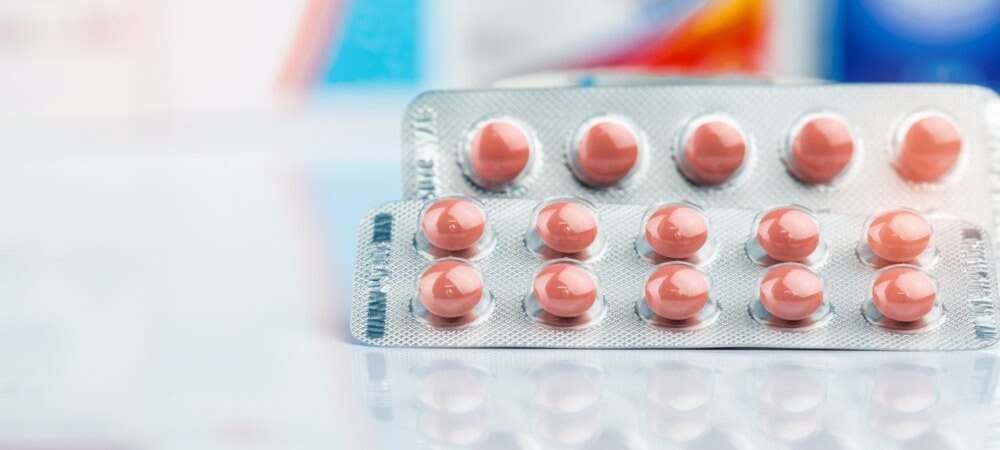
Some over-the-counter medications can be used to treat headaches due to a concussion, but it’s important to know which ones to use.
Immediately after a concussion, patients can use acetaminophen (Tylenol, Aspirin-free Anacin, Feverall, Q-Pap, Mapap), but MUST avoid aspirin, ibuprofen (Advil, Motrin), or naproxen (Aleve), as they may increase the risk of bleeding. If your symptoms are getting worse and you haven’t been evaluated, don’t just rely on painkillers; go to a concussion clinic or the emergency room.
Once the danger of bleeding in the brain has passed, in principle, there are less restrictions regarding what medications you can use. However, it is good to be aware that NSAIDs (non-steroidal anti-inflammatory drugs) like ibuprofen and aspirin may cause gastritis, gastrointestinal bleeding, increased bleeding time, and peptic ulcer disease. For this reason, NSAIDs are not recommended to treat concussion headaches. Acetaminophen (Tylenol) is not an NSAID and is safe to help manage post-traumatic headaches.
My doctor recommended absolute darkness until I feel better; why is Neural Effects’ advice so different?
For years, doctors recommended absolute rest in darkness until symptoms subsided. This meant no work or school, no physical activity, and no screens — or anything else that could worsen symptoms. This advice stemmed largely from the belief that a second impact would have devastating consequences to the brain of patients recovering from a concussion. Out of caution, doctors continued to repeat this advice over and over without much research to back it up.
However, researchers have recently shown there is no added benefit for having an extended rest period beyond 48 hours, and moderate activity may, in fact, improve outcomes for patients.
This is the advice we follow at Neural Effects, but not all doctors specialize in head injuries or are up to date with the latest research. Many doctors are unknowingly offering outdated advice to their patients.
Is it ok to watch TV or play on the computer during my recovery?
Up until recently, it was generally accepted that patients should avoid all use of computer monitors, video games, and televisions until all symptoms resolved. This was typically part of the cocooning protocol (see above).
New evidence has shown that there is no benefit in eliminating screen time during recovery, and patients can, in fact, use electronic devices during their recovery.
However, there are some indications that patients still need to be aware of:
- A period of total rest should be observed for 48 hours after the injury.
- After this rest period, patients can start using devices for a few minutes during the first few days and gradually increase over time.
- Patients can maintain or increase the use of electronic devices as long as it doesn’t worsen symptoms or trigger new ones. If using a screen causes headaches, dizziness, or other symptoms, then you should scale it back. If not, you can continue to progress toward normal levels of use each day.
- Refrain from using these devices at night to ensure it doesn’t interfere with sleep patterns. If you’re having difficulties going to sleep, read some of our tips and tricks to ensure a good night’s sleep.
If you live in Provo, Salt Lake City, or anywhere else in the Utah valley area, we can help you recover from your concussion and reduce your chance of long-term symptoms. We are in network for most types of medical insurance. Schedule your evaluation today.
